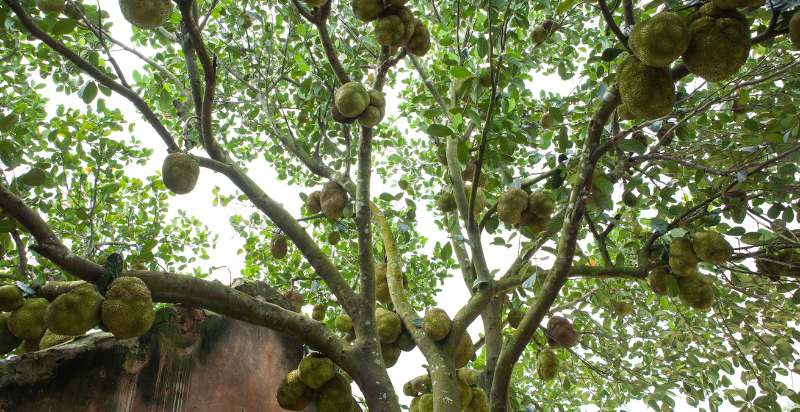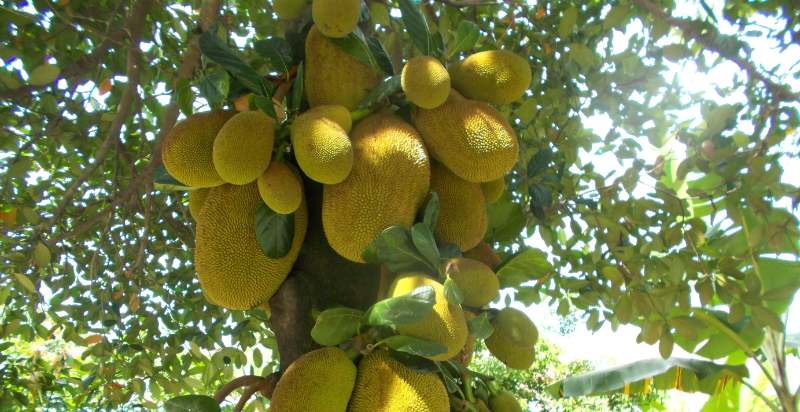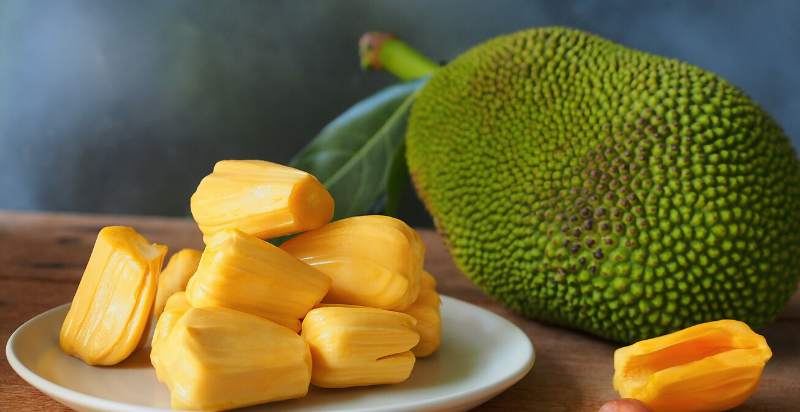Jackfruit, also known as ‘jak’ or ‘jack,’ is a large tropical fruit that grows on the Jackfruit tree. This tree is native to Southeast Asia and has been cultivated for centuries in India, Bangladesh, Sri Lanka, and other parts of the world. It is an important food crop in many countries, and it has become increasingly popular in recent years due to its nutritional benefits and versatility. Here’s everything you need to know about the incredible Jackfruit.
What is Jackfruit?
Jackfruit is a large, oval-shaped fruit with thick, yellowish skin. It can weigh anywhere from 6 to 20 lbs (2.7 to 9 kg). The inside of the Jackfruit is composed of long strings of sweet, fragrant flesh dotted with a few hard seeds. Jackfruit can be eaten raw or cooked and has a unique flavor that is often compared to a banana, pineapple, mango, and other tropical fruits.
History and Origin of Jackfruit:
Jackfruit is a large tropical fruit that is native to India and parts of Southeast Asia. It has been an important part of the region’s cuisine for centuries, but it only gained wider popularity in recent years with its newfound status as a health food. The origin of jackfruit dates back several thousand years, with evidence that it was cultivated in India as early as 2000 BC. From there, its cultivation spread throughout South and Southeast Asia, where it became an integral part of regional cuisines due to its versatility and high nutritional value.
Today, jackfruits are grown all over the world in hot climates like Florida and California in the United States, along with Brazil and other parts of Latin America. Jackfruits can be used in both sweet and savory dishes, and they’re an excellent source of dietary fiber, protein, vitamins, minerals, and antioxidants. Its popularity is only growing as more people learn about its health benefits and how easy it is to cook with. Jackfruits are now widely available in grocery stores worldwide, making it easier than ever to enjoy this delicious fruit!
Varieties of Jackfruit:
Several jackfruit varieties are available, each possessing its unique flavor and texture. Ketola, Thung-Mai, Kaew-Mae, and Sura are the most common varieties. The Ketola is a large green variety with a sweet flesh that is creamy in texture. Some people describe it as an intense aroma similar to bananas or pineapple. The Thung-Mai is slightly smaller than the Ketola, but it still carries a strong scent with a slightly bitter taste. This variety can be eaten raw and cooked in curries or stir fry dishes.
The Kaew-Mae also has a strong smell, but its flavor is more mellow than the Thung-Mai. Its flesh is a bit sweeter and softer in texture than the other varieties. Finally, the Sura is a light yellow variety with a milder taste and is typically used as an ingredient in desserts or smoothies.
Nutritional Value of Jackfruit:
Jackfruit is an incredibly nutritious plant-based food that can benefit your health in various ways. It’s packed with vitamins, minerals, antioxidants, fiber, and other beneficial compounds.
Here’s a look at the nutritional value of jackfruit:
- Calories: One cup (165 grams) of jackfruit provides 95 calories.
- Fat: Jackfruit contains only 0.5 grams per cup — mostly unsaturated fats.
- Protein: Jackfruit contains 2.8 grams of protein per cup — similar to apples or oranges.
- Carbohydrates: Jackfruit is rich in easily digestible carbohydrates, providing 24 grams per cup. Most of these are simple sugars like fructose and sucrose.
- Fiber: Jackfruit is rich in fiber, providing 3.5 grams per cup — 16% of the recommended daily value (DV).
- Vitamins: Jackfruit is an excellent source of vitamins A, C, E, B-6, and riboflavin. It also provides lesser amounts of thiamine and folate.
- Minerals: Jackfruit contains essential minerals like potassium, magnesium, phosphorus, iron, and zinc. It’s especially high in potassium — providing 14% of the DV per cup — more than a banana!
- Phytonutrients: Jackfruit is a rich source of powerful phytonutrients with antioxidant properties. These include carotenes, lutein, flavonoids, and other compounds.
While jackfruit is incredibly nutritious, it’s best to enjoy it in moderation if you’re trying to lose or maintain a healthy weight. Its high sugar content can be problematic for people with diabetes as well. As always, check with your healthcare provider before making any major changes to your diet.
Overall, jackfruit is an incredibly nutritious plant-based food that can benefit your health in many ways. It’s full of vitamins, minerals, antioxidants, and fiber — all essential nutrients for optimal health.
The Health Benefits of Jackfruit:
Jackfruit is a tropical fruit with numerous health benefits. It contains vitamins and minerals, including Vitamins A and C, iron, magnesium, manganese, potassium, and calcium. Jackfruit is also high in fiber and antioxidants, which may help reduce inflammation and the risk of certain diseases. Additionally, its high vitamin content makes it an excellent source of energy.
The flesh of jackfruit can be eaten raw or cooked. It has a sweet flavor similar to pineapple or banana when cooked. It can be used in smoothies, salads, or as an addition to savory dishes such as curries or stir-fries.
Jackfruit is rich in antioxidants that offer several potential health benefits. These include reducing inflammation, aiding digestion, and protecting against certain types of cancer. Additionally, the fiber content may help support healthy blood sugar and cholesterol levels.
In addition to its health benefits, jackfruit is easy to incorporate into a diet as it’s versatile and can be used in sweet and savory recipes. It’s also an excellent plant-based meat substitute for those following vegan or vegetarian diets.
Overall, jackfruit is nutritious and delicious and offers numerous health benefits. Incorporating this tropical treat into your diet could reduce inflammation, aid digestion, lower cholesterol levels, and provide essential vitamins and minerals for overall health.
What are the Uses of Jackfruit?
Jackfruit is a versatile fruit that can be used in numerous ways. It can be consumed as a snack, cooked into savory dishes, or even used to make desserts! The jackfruit’s flesh has an intensely sweet flavor and can be eaten fresh, dried, steamed, boiled, fried, or grilled. Jackfruit is extremely high in nutrients and provides significant amounts of dietary fiber, vitamin A, potassium, and calcium.
The firm texture makes jackfruit perfect for making vegan meat substitutes such as pulled pork or beef-style tacos; it also works great when diced and added to curries or stir-fries. Jackfruit seeds are edible too – they have a somewhat nutty flavor and can be boiled or roasted like other legumes.
Jackfruit is also popularly used as a natural sweetener in desserts, smoothies, and baked goods. Its thick syrup has been used for centuries to make traditional Indian desserts like laddoo and pedal. Additionally, jackfruit can be turned into jams and jellies or blended with other fruits to create an all-natural juice, sorbet, or ice cream!
Overall, jackfruit is incredibly versatile and packed with nutrients; it’s certainly worth exploring if you’re looking for a healthy snack or ingredient option. Its unique texture makes it perfect for savory dishes and sweet treats! Jackfruit is definitely a must-try for those looking to incorporate more plant-based foods into their diet. So why not try it today and discover all the uses of jackfruit?
How to Plant Jackfruit?
Jackfruit is a tropical fruit native to South and Southeast Asia. It’s one of the most popular fruits in the region, prized for its sweet flavor and versatility in cooking. Jackfruit trees are incredibly easy to grow, making them ideal for home gardens and orchards. You can enjoy your delicious jackfruit with proper care within just a few years of planting!
Location Selection:
When selecting a spot for planting your jackfruit tree, consider finding a place with plenty of bright sunlight. Jackfruits thrive best in temperatures between 70°F and 90°F (21°C-32°C), so the area must receive plenty of direct sun throughout the day. Additionally, select a place with well-drained soil, as this will help ensure the tree thrives. If you’re growing jackfruit in pots indoors or outdoors, make sure the pot has plenty of holes for drainage.
Planting Your Tree:
When choosing where to plant your jackfruit tree, keep in mind that it needs plenty of suns and well-draining soil. Planting in a sunny spot will ensure optimal growth and fruit production. If you’re planting more than one jackfruit tree, space them at least 10 feet apart to give each room to grow.
Once you’ve chosen the perfect spot, prepare your soil so it’s loose and free of debris or weeds. Dig a hole slightly larger than the root ball of your tree, then place it in the hole and fill it with soil. Tamp down gently and water until evenly moistened throughout.
Care and Maintenance:
Jackfruit tree is relatively low-maintenance and need minimal pruning to keep them healthy. Avoid pruning during the growing season (spring through fall), as this can stunt growth or cause sunburn on young leaves. Instead, wait until winter, when they’re dormant, to shape them up by removing dead branches or crossing limbs.
Jackfruit tree will need regular watering to stay healthy and produce fruit. Water deeply, at least once a week during the growing season or as needed if you’re in a particularly dry climate. Feeding your tree with a balanced fertilizer every few months is important to ensure optimal growth and fruit production.
Harvesting:
Jackfruit tree can take 2 – 5 years to produce fruit, depending on the variety you grow. When ready to harvest, jackfruit will be bright green and soft when touched. You can pick the fruit by hand or use pruning shears for larger branches. Enjoy ripe jackfruit fresh off the tree, or store it in the refrigerator for later use.
Planting and caring for a jackfruit tree is surprisingly easy and rewarding! With the right care, you’ll enjoy fresh fruit from your garden in no time. Follow the planting and care instructions outlined above to ensure your tree stays healthy and productive for years to come.
How to Care for and Grow Jackfruit?
Jackfruit is one of the world’s most popular and widely cultivated tropical fruit trees. They are native to south and southeast Asian countries, including India, Sri Lanka, Malaysia, Indonesia, Philippines, Thailand, Vietnam, and Nepal. Knowing how to properly care for and grow Jackfruit is important because it requires special soil conditions and some other specific requirements.
Location
The best location for growing Jackfruit is a sunny spot with good drainage. The tree will not do well if planted in an area that remains wet or has poor drainage, which can lead to root rot. When selecting a planting location for Jackfruit, ensure there is enough space away from structures such as buildings, as the tree can reach heights of up to 20 feet.
Soil Requirements
Jackfruit tree prefers sandy loam soil with plenty of organic matter and a pH between 6-7.5. Adding compost or aged manure to the soil will help boost fertility and retain moisture, while adding some sulfur helps reduce the alkalinity of the soil if needed. Additionally, well-drained soils are best for Jackfruit as they can suffer from root rot in saturated soils.
Watering
Jackfruit tree requires regular watering during the growing season (spring and summer). It is recommended to water about once every two weeks or when the top 4 inches of soil are dry since overwatering can lead to root rot. More frequent watering may be needed during periods of drought or extreme heat.
Fertilizing
Jackfruit trees should be fertilized at least once a year, preferably in early spring before the start of the growing season. A balanced fertilizer with equal nitrogen, phosphorus, and potassium (10-10-10) is ideal for Jackfruit trees. However, organic fertilizers such as compost or aged manure can also be used. It is important to avoid over-fertilization as this could burn the tree’s roots and damage it.
Pruning
Pruning Jackfruit trees helps encourage healthy growth and encourages fruiting by removing dead or diseased branches and thinning out crowded areas. Pruning should be done in late winter or early spring while the tree is still dormant and before the growing season starts.
Harvesting
Jackfruit is ready for harvest when soft to the touch, usually about 5-7 months after flowering. When harvesting, use a sharp knife or shear to cut the fruit from the stem and handle it gently, as it can bruise easily. The fruit can be eaten fresh or used in recipes such as desserts, salads, smoothies, and more.
With proper care and maintenance, Jackfruit is an easy tropical fruit tree to grow that will provide you with delicious fruits year after year! With these tips on caring for and growing Jackfruit, you should have no problem growing a healthy and productive tree.

Preventions from Pests and Diseases of Jackfruit:
The following are some steps that growers of jackfruit can take to prevent or minimize damage from pests and diseases:
- Planting Resistant Varieties: One of the most effective ways to prevent pests and diseases is to plant resistant varieties. Wide varieties of jackfruit are available, and some are more resistant than others to certain pests and diseases.
- Crop Rotations: Practices that involve planting a different crop in the same field each year can help reduce pest and disease problems. This is because different crops tend to attract different types of pests or diseases, so by changing what you’re growing each year, you can keep potential problems at bay. Additionally, rotating crops can also help improve soil fertility over time.
- Proper Irrigation Management: Growers must ensure that their jackfruit trees get the right amount of water. Over or under-watering can make trees more vulnerable to pests and diseases, so it is important to follow best practices regarding irrigation management.
- Fertilization: Applying fertilizer to jackfruit trees can help them resist pests and diseases by promoting healthy growth. However, it is important to use the correct fertilizer type to avoid potential problems.
- Pruning: Regularly pruning jackfruit trees can also help reduce pest and disease problems, as this helps keep trees healthy and vigorous. Growers must use proper pruning techniques to avoid damaging the tree’s structure.
- Sanitation: Keeping tools, equipment, and work areas clean can help reduce the spread of pests and diseases. Growers need to clean or sterilize their pruning shears and other tools after each use to prevent the spread of disease from one tree to another.
Taking preventive measures against pests and diseases is essential to producing a successful jackfruit harvest. Following the steps outlined above, growers can better protect their crops from potential problems impacting yields and quality. Proper care and attention make it possible to produce high-quality jackfruit throughout the year.
How to Harvest Jackfruit?
Harvesting jackfruit can be tricky due to its size, weight, and spiky exterior. This section will provide you with a step-by-step guide on how to harvest jackfruit safely and easily.
Step 1: Identify Ripe Jackfruits
When harvesting jackfruit, it is important to identify ripe fruits. A ripe jackfruit should have a yellowish-brown color with dark spots or patches on the outside of the skin. You can also tell if it is ripe by gently pressing your finger against the surface; if it feels soft, it is ripe.
Step 2: Wear Protective Gear
Jackfruit can be quite spiky, so you must wear protective gear while harvesting the fruit. We recommend wearing a long-sleeve shirt, pants, and gloves to protect your skin from sharp spikes. If possible, bring a ladder, as jackfruits are usually found high up in trees and may require additional support for harvest.
Step 3: Cut Open The Fruit
Once you have identified a ripe jackfruit, use a knife or scissors to cut open the fruit at its stem. Carefully remove any fruit spikes that may still be attached to the skin before cutting it open. Be sure not to cut too deep, as this can damage the fruit’s flesh and render it inedible.
Step 4: Remove The Flesh
Once you have cut open the jackfruit, you can remove its flesh. Use a spoon or spatula to carefully scrape out the inner core of the fruit, which is where most of its sweetness comes from. You may also need to use your fingers to help pull away any stringy pieces of flesh still attached to the core.
Step 5: Rinse And Serve
Once the jackfruits have been removed from their skin, rinse them with water before serving. Jackfruit can be eaten fresh or cooked into dishes such as curries, desserts, and salads. Enjoy!
Harvesting jackfruit can be tricky, but with the right tools and technique, you can do it safely and easily. We hope this step-by-step guide has provided you with all the information you need to harvest your jackfruits.

How to Store Homegrown Jackfruit?
Storing homegrown jackfruit is a great way to make sure you have fresh, delicious fruit all year round. Jackfruit is delicious and has many nutritional benefits, making it a healthy choice for your family. However, storing jackfruit can be tricky due to its bulky shape and size. This section will provide a step-by-step guide on how to store homegrown jackfruit properly so that it stays tasty and nutritious for as long as possible.
1. Choose Your Ripeness Wisely
When choosing the perfect ripeness for your homegrown jackfruit, look for one slightly yellow with an orange tinge. The riper the fruit, the softer and juicier it will be, so choose wisely. Avoid choosing too ripe fruit, as this will make it more prone to bruising and spoilage.
2. Clean Before Storing
Once you have chosen the perfect jackfruit, please clean it before storing it. Make sure to remove any dirt or debris on the outside of the fruit and any seeds inside. This will help keep bacteria away and prevent spoilage.
3. Store in a Refrigerator
The best way to store homegrown jackfruit is in the refrigerator, preferably at a temperature between 33-36°F (1-2°C). To ensure maximum freshness for longer periods, wrap your jackfruit tightly in wax paper or plastic before placing it in the refrigerator.
4. Freeze Jackfruit for Longer Storage
If you plan on storing jackfruit for longer periods of time, freezing is an option:
- Cut your jackfruit into smaller pieces and remove any seeds inside.
- Place your cut pieces onto a baking sheet lined with parchment paper. Place the tray in the freezer until frozen solid (about 4 hours).
- Transfer your jackfruit to an airtight container or bag and store it in the freezer for up to 6 months.
Storing homegrown jackfruit properly will help ensure that you have fresh and delicious fruit all year round. Following these steps will ensure that your fruit stays juicy, nutritious, and safe. So go ahead and enjoy your homegrown jackfruit, knowing that you have stored it safely!

How to use Homegrown Jackfruit in your day-to-day life?
Homegrown jackfruit is an incredibly versatile fruit that can be used in a variety of ways. Whether you’re looking to add some tropical flair to your dishes or simply curious about the sweet, juicy flavor of this unique fruit, here are some tips on how to use homegrown jackfruit:
- To make a delicious smoothie – blend fresh jackfruit with banana, coconut milk, and honey for a deliciously creamy breakfast treat.
- Add it to curries – the sweetness of jackfruit makes it perfect for adding body and flavor to curries. Simply stew cubes of jackfruit alongside potatoes and other vegetables such as carrots and beans.
- Make tacos – shred cooked jackfruit into small pieces and fry in a pan with taco seasoning for a vegan-friendly filling.
- Enjoy it on its own – jackfruit can simply be eaten as is, making it the perfect snack option. Cut into wedges and sprinkle with a little sea salt or sugar for an extra hit of flavor.
- Use it to make burgers – jackfruit is incredibly meaty, making it a great vegetarian alternative to beef patties. Mix canned jackfruit (pre-seasoned) with diced onion, garlic, breadcrumbs, and herbs until you have a thick mixture that can be molded into patties and then fried in oil or cooked on the BBQ for added smokiness.
- Jazz up salads – diced jackfruit works well in salads and is a great source of plant-based protein. Try adding it to quinoa or rice bowls with other ingredients such as roasted sweet potatoes, avocado, spinach, and feta cheese.
- Bake it into dessert – when fully ripe, homegrown jackfruit has an intense sweetness, making it ideal for baking cakes and muffins. Mix pureed jackfruit into the batter alongside spices such as cardamom, nutmeg, and cinnamon for a truly delicious treat.
These are just some ways you can use homegrown jackfruit in your day-to-day life! Give them a try and discover just how versatile this tropical fruit is. Enjoy!

Potential Risks from Jackfruit in your day-to-day life:
While Jackfruit is generally considered safe to consume, there are potential risks associated with eating this fruit. Too much fruit can cause several gastric issues, such as diarrhea and cramping. Unripe jackfruit may also contain toxins that can irritate the stomach and cause nausea and vomiting.
Another risk associated with eating jackfruit is its high sugar content. Because it’s sweet, some people overindulge eating jackfruit, leading to elevated blood sugar levels. Additionally, individuals allergic to other fruits like mango or banana may be at risk for an allergic reaction when consuming jackfruit.
Finally, due to its thick outer skin, unripe jackfruit can contain mold and fungi, which can potentially cause food poisoning and other health problems. Therefore, you should always purchase ripe jackfruit and store it in the refrigerator before eating.
Overall, Jackfruit is a nutritious and delicious snack that can be enjoyed as part of a balanced diet. However, there are potential risks associated with consuming this fruit, so it’s important to be aware of these before eating it regularly. Be sure to buy ripe jackfruit, eat it in moderation, and consult your doctor if you experience any adverse reactions.
By following these precautions, you can enjoy Jackfruit’s many benefits without worrying about any potential risks!
Conclusion:
Jackfruit is an incredibly versatile and nutritious fruit that can be enjoyed in many different ways. Jackfruit is a great addition to any diet, from smoothies to curries, tacos to burgers. However, it’s important to consider the potential risks of eating this fruit, such as allergies or food poisoning.
Be sure to buy ripe jackfruit and store it properly before consuming, and always talk to your doctor if you experience any adverse reactions. With these precautions, you can enjoy homegrown Jackfruit’s benefits without worrying about any potential risks! Enjoy! Happy cooking!
- Everything You Wanted to Know About Red Tamarillos - June 2, 2025
- A Guide to Tulips: Everything You Need to Know & More… - June 2, 2025
- Guanabana: Description, Flavor, Benefits, And Uses - May 27, 2025

3 thoughts on “What is Jackfruit ? How to Plant, Grow, and Harvest Jackfruit”
Comments are closed.